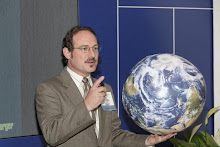The Houston Geological Society, which bills itself on its website as “the world’s largest local geological society” (and if Houston continues to hold its place among the five Texas cities in the top ten on the Men’s Health annual list of “America’s Fattest Cities", this may be literally true), held an Environmental and Engineering Dinner meeting on 14-Dec to discuss the technology behind risk mitigation for shale gas development. Anthony Gorody, president of Universal Geoscience Consulting, Inc., has been very involved in baseline groundwater sampling and forensic analysis of stray gas in shallow water wells. This was especially timely given the recent identification in Pavillion, Wyoming of compounds in two deep monitoring wells (see the draft report at: http://www.epa.gov/region8/superfund/wy/pavillion/EPA_ReportOnPavillion_Dec-8-2011.pdf) that the EPA described in their press release as “consistent with gas production”. Mr. Gorody repeated the industry’s stance that relatively few water wells are impacted by drilling operations and that to date there have been no unambiguously documented cases of groundwater contamination directly attributed to hydraulic fracturing itself. Instead, he showed that many issues have been with stray gas being released from insufficient cement jobs rather than completion operations (note even the EPA report references “gas production” first rather than hydraulic fracturing). Compounding the issue is the fact that drilling operations have now moved from areas like Wyoming, where a one mile radius of investigation around a gas well might encounter only two water wells, to populated lands in Pennsylvania, where the same footprint might include up to 60 privately drilled water wells. Gorody noted that hydraulic fracturing is not a new technology (it has been in use since 1947) and showed what may be the best image in the public domain to explain the relationship between the depth of water wells and the depth and extent of hydraulic fracturing, which should allow the general public to understand the physical inability of artificial fractures to propagate to groundwater levels in a play like the Barnett.
He used some basic physics to show that small shale pores are two orders of magnitude smaller than the molecular sizes of larger hydrocarbons, and that fractures must be vertically confined in order to create strain release, and slammed the recent EPA report for confusing “coincidence and collocation with cause and effect”. He gave a rule of thumb that the energy released in a typical fracture job is about the same as dropping a gallon of water from head height, while the audience tried to imagine that amount of energy fracturing over 3000 feet of consolidated rock. The high visibility and impact of shale gas drilling operations, however, with 3-5 million gallons of water being trucked in per well, and highly mobile rigs moving through what used to be rural countrysides, has led many community organizations to cast a skeptical eye on the industry. Gorody emphasized the impact on instrumentation and monitoring technology, showing that pressure plots and noise surveys do not show any evidence of fluid or gas release, that increased sampling and analysis of gas shows is providing a fossilized history of hydrocarbon expulsion in many basins, and that baseline water sampling is providing a boon in data density and data mining for forensic geochemists studying aquifers, paid for by risk-averse and litigation-wary operators. The voluntary and regulatory release of chemical information supports studies that show produced gases are not isotopically the same as gases found in water wells, and that buoyant hydrocarbons from depth escaping from failed casings, uncemented annuli, and compromised casing cement bonds can invade shallow aquifers and re-suspend colloidal complexes and sediments that have normally settled to the bottom of water wells. This creates a reducing environment in the well pump intake port, and the bacterial conversion of toxic sulfides that are then reported as odiferous and noxious. It only takes 87 psi of stray gas to overcome hydraulic head and invade water wells drilled to 200 feet, that is less than the pressure in a standard bicycle tire. Since around 85% of the population can detect sulfides such as H2S at levels of .03 ppm, the population quickly becomes aware of the degradation of their water supply, but Gorody noted that this process is completely independent of the hydraulic fracturing used to complete the well, and that maybe the term “hydraulic fracturing” should not even be used when describing vertical wells. Gorody pointed out that as soon as the annulus is squeezed, the problems with water contamination that occur in the first weeks to months after drilling go away, and that nearby monitoring wells may fail to intersect the tortuous paths used by the stray gas to migrate between the gas producing and water wells. His suggestions for reducing these impacts include monitoring of mud logs for gas shows during drilling, cementing off shallow gas shows to prevent leakage, sampling gas for its isotopic fingerprint during drilling to differentiate it from produced gas, running cement bond logs, and coproducing or venting casinghead gas. In the end, it was very enlightening to hear such a sober, scientific evaluation of the technology being used to track gas in shale plays, as opposed to the usual dialogue in places like mainstream media.
Thursday, January 19, 2012
Subscribe to:
Posts (Atom)
